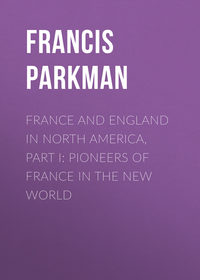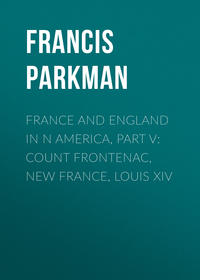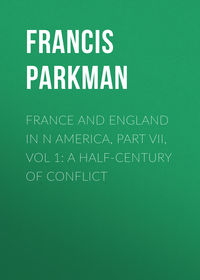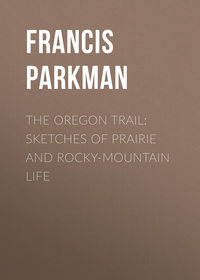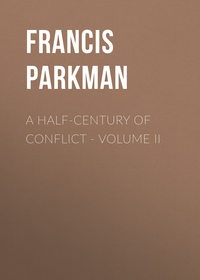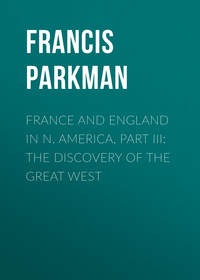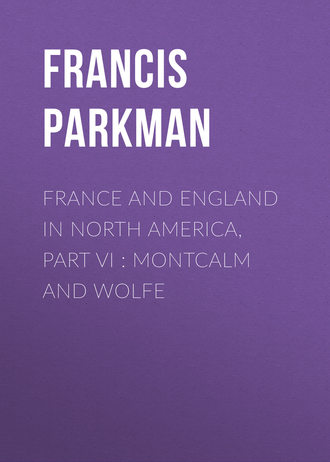 полная версия
полная версияFrance and England in North America, Part VI : Montcalm and Wolfe
The course of the party lay up the Miami; and they toiled thirteen days against the shallow current before they reached a village of the Miami Indians, lately built at the mouth of the rivulet now called Loramie Creek. Over it ruled a chief to whom the French had given the singular name of La Demoiselle, but whom the English, whose fast friend he was, called Old Britain. The English traders who lived here had prudently withdrawn, leaving only two hired men in the place. The object of Cèloron was to induce the Demoiselle and his band to leave this new abode and return to their old villages near the French fort on the Maumee, where they would be safe from English seduction. To this end, he called them to a council, gave them ample gifts, and made them an harangue in the name of the Governor. The Demoiselle took the gifts, thanked his French father for his good advice, and promised to follow it at a more convenient time.11 In vain Céloron insisted that he and his tribesmen should remove at once. Neither blandishments nor threats would prevail, and the French commander felt that his negotiation had failed.
He was not deceived. Far from leaving his village, the Demoiselle, who was Great Chief of the Miami Confederacy, gathered his followers to the spot, till, less than two years after the visit of Céloron, its population had increased eightfold. Pique Town, or Pickawillany, as the English called it, became one of the greatest Indian towns of the West, the centre of English trade and influence, and a capital object of French jealousy.
Céloron burned his shattered canoes, and led his party across the long and difficult portage to the French post on the Maumee, where he found Raymond, the commander, and all his men, shivering with fever and ague. They supplied him with wooden canoes for his voyage down the river; and, early in October, he reached Lake Erie, where he was detained for a time by a drunken debauch of his Indians, who are called by the chaplain "a species of men made to exercise the patience of those who have the misfortune to travel with them." In a month more he was at Fort Frontenac; and as he descended thence to Montreal, he stopped at the Oswegatchie, in obedience to the Governor, who had directed him to report the progress made by the Sulpitian, Abbé Piquet, at his new mission. Piquet's new fort had been burned by Indians, prompted, as he thought, by the English of Oswego; but the priest, buoyant and undaunted, was still resolute for the glory of God and the confusion of the heretics.
At length Céloron reached Montreal; and, closing his Journal, wrote thus: "Father Bonnecamp, who is a Jesuit and a great mathematician, reckons that we have travelled twelve hundred leagues; I and my officers think we have travelled more. All I can say is, that the nations of these countries are very ill-disposed towards the French, and devoted entirely to the English."12 If his expedition had done no more, it had at least revealed clearly the deplorable condition of French interests in the West.
While Céloron was warning English traders from the Ohio, a plan was on foot in Virginia for a new invasion of the French domain. An association was formed to settle the Ohio country; and a grant of five hundred thousand acres was procured from the King, on condition that a hundred families should be established upon it within seven years, a fort built, and a garrison maintained. The Ohio Company numbered among its members some of the chief men of Virginia, including two brothers of Washington; and it had also a London partner, one Hanbury, a person of influence, who acted as its agent in England. In the year after the expedition of Céloron, its governing committee sent the trader Christopher Gist to explore the country and select land. It must be "good level land," wrote the Committee; "we had rather go quite down to the Mississippi than take mean, broken land."13 In November Gist reached Logstown, the Chiningué of Céloron, where he found what he calls a "parcel of reprobate Indian traders." Those whom he so stigmatizes were Pennsylvanians, chiefly Scotch-Irish, between whom and the traders from Virginia there was great jealousy. Gist was told that he "should never go home safe." He declared himself the bearer of a message from the King. This imposed respect, and he was allowed to proceed. At the Wyandot village of Muskingum he found the trader George Croghan, sent to the Indians by the Governor of Pennsylvania, to renew the chain of friendship.14 "Croghan," he says, "is a mere idol among his countrymen, the Irish traders;" yet they met amicably, and the Pennsylvanian had with him a companion, Andrew Montour, the interpreter, who proved of great service to Gist. As Montour was a conspicuous person in his time, and a type of his class, he merits a passing notice. He was the reputed grandson of a French governor and an Indian squaw. His half-breed mother, Catharine Montour, was a native of Canada, whence she was carried off by the Iroquois, and adopted by them. She lived in a village at the head of Seneca Lake, and still held the belief, inculcated by the guides of her youth, that Christ was a Frenchman crucified by the English.15 Her son Andrew is thus described by the Moravian Zinzendorf, who knew him: "His face is like that of a European, but marked with a broad Indian ring of bear's-grease and paint drawn completely round it. He wears a coat of fine cloth of cinnamon color, a black necktie with silver spangles, a red satin waistcoat, trousers over which hangs his shirt, shoes and stockings, a hat, and brass ornaments, something like the handle of a basket, suspended from his ears."16 He was an excellent interpreter, and held in high account by his Indian kinsmen.
After leaving Muskingum, Gist, Croghan, and Montour went together to a village on White Woman's Creek,—so called from one Mary Harris, who lived here. She was born in New England, was made prisoner when a child forty years before, and had since dwelt among her captors, finding such comfort as she might in an Indian husband and a family of young half-breeds. "She still remembers," says Gist, "that they used to be very religious in New England, and wonders how white men can be so wicked as she has seen them in these woods." He and his companions now journeyed southwestward to the Shawanoe town at the mouth of the Scioto, where they found a reception very different from that which had awaited Céloron. Thence they rode northwestward along the forest path that led to Pickawillany, the Indian town on the upper waters of the Great Miami. Gist was delighted with the country; and reported to his employers that "it is fine, rich, level land, well timbered with large walnut, ash, sugar trees and cherry trees; well watered with a great number of little streams and rivulets; full of beautiful natural meadows, with wild rye, blue-grass, and clover, and abounding with turkeys, deer, elks, and most sorts of game, particularly buffaloes, thirty or forty of which are frequently seen in one meadow." A little farther west, on the plains of the Wabash and the Illinois, he would have found them by thousands.
They crossed the Miami on a raft, their horses swimming after them; and were met on landing by a crowd of warriors, who, after smoking with them, escorted them to the neighboring town, where they were greeted by a fusillade of welcome. "We entered with English colors before us, and were kindly received by their king, who invited us into his own house and set our colors upon the top of it; then all the white men and traders that were there came and welcomed us." This "king" was Old Britain, or La Demoiselle. Great were the changes here since Céloron, a year and a half before, had vainly enticed him to change his abode, and dwell in the shadow of the fleur-de-lis. The town had grown to four hundred families, or about two thousand souls; and the English traders had built for themselves and their hosts a fort of pickets, strengthened with logs.
There was a series of councils in the long house, or town-hall. Croghan made the Indians a present from the Governor of Pennsylvania; and he and Gist delivered speeches of friendship and good advice, which the auditors received with the usual monosyllabic plaudits, ejected from the depths of their throats. A treaty of peace was solemnly made between the English and the confederate tribes, and all was serenity and joy; till four Ottawas, probably from Detroit, arrived with a French flag, a gift of brandy and tobacco, and a message from the French commandant inviting the Miamis to visit him. Whereupon the great war-chief rose, and, with "a fierce tone and very warlike air," said to the envoys: "Brothers the Ottawas, we let you know, by these four strings of wampum, that we will not hear anything the French say, nor do anything they bid us." Then addressing the French as if actually present: "Fathers, we have made a road to the sun-rising, and have been taken by the hand by our brothers the English, the Six Nations, the Delawares, Shawanoes, and Wyandots.17 We assure you, in that road we will go; and as you threaten us with war in the spring, we tell you that we are ready to receive you." Then, turning again to the four envoys: "Brothers the Ottawas, you hear what I say. Tell that to your fathers the French, for we speak it from our hearts." The chiefs then took down the French flag which the Ottawas had planted in the town, and dismissed the envoys with their answer of defiance.
On the next day the town-crier came with a message from the Demoiselle, inviting his English guests to a "feather dance," which Gist thus describes: "It was performed by three dancing-masters, who were painted all over of various colors, with long sticks in their hands, upon the ends of which were fastened long feathers of swans and other birds, neatly woven in the shape of a fowl's wing; in this disguise they performed many antic tricks, waving their sticks and feathers about with great skill, to imitate the flying and fluttering of birds, keeping exact time with their music." This music was the measured thumping of an Indian drum. From time to time a warrior would leap up, and the drum and the dancers would cease as he struck a post with his tomahawk, and in a loud voice recounted his exploits. Then the music and the dance began anew, till another warrior caught the martial fire, and bounded into the circle to brandish his tomahawk and vaunt his prowess.
On the first of March Gist took leave of Pickawillany, and returned towards the Ohio. He would have gone to the Falls, where Louisville now stands, but for a band of French Indians reported to be there, who would probably have killed him. After visiting a deposit of mammoth bones on the south shore, long the wonder of the traders, he turned eastward, crossed with toil and difficulty the mountains about the sources of the Kenawha, and after an absence of seven months reached his frontier home on the Yadkin, whence he proceeded to Roanoke with the report of his journey.18
All looked well for the English in the West; but under this fair outside lurked hidden danger. The Miamis were hearty in the English cause, and so perhaps were the Shawanoes; but the Delawares had not forgotten the wrongs that drove them from their old abodes east of the Alleghanies, while the Mingoes, or emigrant Iroquois, like their brethren of New York, felt the influence of Joncaire and other French agents, who spared no efforts to seduce them.19 Still more baneful to British interests were the apathy and dissensions of the British colonies themselves. The Ohio Company had built a trading-house at Will's Creek, a branch of the Potomac, to which the Indians resorted in great numbers; whereupon the jealous traders of Pennsylvania told them that the Virginians meant to steal away their lands. This confirmed what they had been taught by the French emissaries, whose intrigues it powerfully aided. The governors of New York, Pennsylvania, and Virginia saw the importance of Indian alliances, and felt their own responsibility in regard to them; but they could do nothing without their assemblies. Those of New York and Pennsylvania were largely composed of tradesmen and farmers, absorbed in local interests, and possessed by two motives,—the saving of the people's money, and opposition to the governor, who stood for the royal prerogative. It was Hamilton, of Pennsylvania, who had sent Croghan to the Miamis to "renew the chain of friendship;" and when the envoy returned, the Assembly rejected his report. "I was condemned," he says, "for bringing expense on the Government, and the Indians were neglected."20 In the same year Hamilton again sent him over the mountains, with a present for the Mingoes and Delawares. Croghan succeeded in persuading them that it would be for their good if the English should build a fortified trading-house at the fork of the Ohio, where Pittsburg now stands; and they made a formal request to the Governor that it should be built accordingly. But, in the words of Croghan, the Assembly "rejected the proposal, and condemned me for making such a report." Yet this post on the Ohio was vital to English interests. Even the Penns, proprietaries of the province, never lavish of their money, offered four hundred pounds towards the cost of it, besides a hundred a year towards its maintenance; but the Assembly would not listen.21 The Indians were so well convinced that a strong English trading-station in their country would add to their safety and comfort, that when Pennsylvania refused it, they repeated the proposal to Virginia; but here, too, it found for the present little favor.
The question of disputed boundaries had much to do with this most impolitic inaction. A large part of the valley of the Ohio, including the site of the proposed establishment, was claimed by both Pennsylvania and Virginia; and each feared that whatever money it might spend there would turn to the profit of the other. This was not the only evil that sprang from uncertain ownership. "Till the line is run between the two provinces," says Dinwiddie, governor of Virginia, "I cannot appoint magistrates to keep the traders in good order."22 Hence they did what they pleased, and often gave umbrage to the Indians. Clinton, of New York, appealed to his Assembly for means to assist Pennsylvania in "securing the fidelity of the Indians on the Ohio," and the Assembly refused.23 "We will take care of our Indians, and they may take care of theirs:" such was the spirit of their answer. He wrote to the various provinces, inviting them to send commissioners to meet the tribes at Albany, "in order to defeat the designs and intrigues of the French." All turned a deaf ear except Massachusetts, Connecticut, and South Carolina, who sent the commissioners, but supplied them very meagrely with the indispensable presents.24 Clinton says further: "The Assembly of this province have not given one farthing for Indian affairs, nor for a year past have they provided for the subsistence of the garrison at Oswego, which is the key for the commerce between the colonies and the inland nations of Indians."25
In the heterogeneous structure of the British colonies, their clashing interests, their internal disputes, and the misplaced economy of penny-wise and short-sighted assembly-men, lay the hope of France. The rulers of Canada knew the vast numerical preponderance of their rivals; but with their centralized organization they felt themselves more than a match for any one English colony alone. They hoped to wage war under the guise of peace, and to deal with the enemy in detail; and they at length perceived that the fork of the Ohio, so strangely neglected by the English, formed, together with Niagara, the key of the Great West. Could France hold firmly these two controlling passes, she might almost boast herself mistress of the continent.
Note.—The Journal of Céloron (Archives de la Marine) is very long and circumstantial, including the procès verbaux, and reports of councils with Indians. The Journal of the chaplain, Bonnecamp (Dépôt de la Marine), is shorter, but is the work of an intelligent and observing man. The author, a Jesuit, was skilled in mathematics, made daily observations, and constructed a map of the route, still preserved at the Dépôt de la Marine. Concurrently with these French narratives, one may consult the English letters and documents bearing on the same subjects, in the Colonial Records of Pennsylvania, the Archives of Pennsylvania, and the Colonial Documents of New York.
Three of Céloron's leaden plates have been found,—the two mentioned in the text, and another which was never buried, and which the Indians, who regarded these mysterious tablets as "bad medicine," procured by a trick from Joncaire, or, according to Governor Clinton, stole from him. A Cayuga chief brought it to Colonel Johnson, on the Mohawk, who interpreted the "Devilish writing" in such a manner as best to inspire horror of French designs.
CHAPTER III.
1749-1753
CONFLICT FOR THE WESTThe Five Nations • Caughnawaga • Abbé Piquet • His Schemes • His Journey • Fort Frontenac • Toronto • Niagara • Oswego • Success of Piquet • Detroit • La Jonquière • His Intrigues • His Trials • His Death • English Intrigues • Critical State of the West • Pickawillany Destroyed • Duquesne • His Grand Enterprise.
The Iroquois, or Five Nations, sometimes called Six Nations after the Tuscaroras joined them, had been a power of high importance in American international politics. In a certain sense they may be said to have held the balance between their French and English neighbors; but their relative influence had of late declined. So many of them had emigrated and joined the tribes of the Ohio, that the centre of Indian population had passed to that region. Nevertheless, the Five Nations were still strong enough in their ancient abodes to make their alliance an object of the utmost consequence to both the European rivals. At the western end of their "Long House," or belt of confederated villages, Joncaire intrigued to gain them for France; while in the east he was counteracted by the young colonel of militia, William Johnson, who lived on the Mohawk, and was already well skilled in managing Indians. Johnson sometimes lost his temper; and once wrote to Governor Clinton to complain of the "confounded wicked things the French had infused into the Indians' heads; among the rest that the English were determined, the first opportunity, to destroy them all. I assure your Excellency I had hard work to beat these and several other cursed villanous things, told them by the French, out of their heads."26
In former times the French had hoped to win over the Five Nations in a body, by wholesale conversion to the Faith; but the attempt had failed. They had, however, made within their own limits an asylum for such converts as they could gain, whom they collected together at Caughnawaga, near Montreal, to the number of about three hundred warriors.27 These could not be trusted to fight their kinsmen, but willingly made forays against the English borders. Caughnawaga, like various other Canadian missions, was divided between the Church, the army, and the fur-trade. It had a chapel, fortifications, and storehouses; two Jesuits, an officer, and three chief traders. Of these last, two were maiden ladies, the Demoiselles Desauniers; and one of the Jesuits, their friend Father Tournois, was their partner in business. They carried on by means of the Mission Indians, and in collusion with influential persons in the colony, a trade with the Dutch at Albany, illegal, but very profitable.28
Besides this Iroquois mission, which was chiefly composed of Mohawks and Oneidas, another was now begun farther westward, to win over the Onondagas, Cayugas, and Senecas. This was the establishment of Father Piquet, which Céloron had visited in its infancy when on his way to the Ohio, and again on his return. Piquet was a man in the prime of life, of an alert, vivacious countenance, by no means unprepossessing;29 an enthusiastic schemer, with great executive talents; ardent, energetic, vain, self-confident, and boastful. The enterprise seems to have been of his own devising; but it found warm approval from the Government.30 La Présentation, as he called the new mission, stood on the bank of the River Oswegatchie where it enters the St. Lawrence. Here the rapids ceased, and navigation was free to Lake Ontario. The place commanded the main river, and could bar the way to hostile war-parties or contraband traders. Rich meadows, forests, and abundance of fish and game, made it attractive to Indians, and the Oswegatchie gave access to the Iroquois towns. Piquet had chosen his site with great skill. His activity was admirable. His first stockade was burned by Indian incendiaries; but it rose quickly from its ashes, and within a year or two the mission of La Présentation had a fort of palisades flanked with blockhouses, a chapel, a storehouse, a barn, a stable, ovens, a saw-mill, broad fields of corn and beans, and three villages of Iroquois, containing, in all, forty-nine bark lodges, each holding three or four families, more or less converted to the Faith; and, as time went on, this number increased. The Governor had sent a squad of soldiers to man the fort, and five small cannon to mount upon it. The place was as safe for the new proselytes as it was convenient and agreeable. The Pennsylvanian interpreter, Conrad Weiser, was told at Onondaga, the Iroquois capital, that Piquet had made a hundred converts from that place alone; and that, "having clothed them all in very fine clothes, laced with silver and gold, he took them down and presented them to the French Governor at Montreal, who received them very kindly, and made them large presents."31
Such were some of the temporal attractions of La Présentation. The nature of the spiritual instruction bestowed by Piquet and his fellow-priests may be partly inferred from the words of a proselyte warrior, who declared with enthusiasm that he had learned from the Sulpitian missionary that the King of France was the eldest son of the wife of Jesus Christ.32 This he of course took in a literal sense, the mystic idea of the Church as the spouse of Christ being beyond his savage comprehension. The effect was to stimulate his devotion to the Great Onontio beyond the sea, and to the lesser Onontio who represented him as Governor of Canada.
Piquet was elated by his success; and early in 1752 he wrote to the Governor and Intendant: "It is a great miracle that, in spite of envy, contradiction, and opposition from nearly all the Indian villages, I have formed in less than three years one of the most flourishing missions in Canada. I find myself in a position to extend the empire of my good masters, Jesus Christ and the King, even to the extremities of this new world; and, with some little help from you, to do more than France and England have been able to do with millions of money and all their troops."33
The letter from which this is taken was written to urge upon the Government a scheme in which the zealous priest could see nothing impracticable. He proposed to raise a war-party of thirty-eight hundred Indians, eighteen hundred of whom were to be drawn from the Canadian missions, the Five Nations, and the tribes of the Ohio, while the remaining two thousand were to be furnished by the Flatheads, or Choctaws, who were at the same time to be supplied with missionaries. The united force was first to drive the English from the Ohio, and next attack the Dog Tribe, or Cherokees, who lived near the borders of Virginia, with the people of which they were on friendly terms. "If," says Piquet, "the English of Virginia give any help to this last-named tribe,—which will not fail to happen,—they [the war-party] will do their utmost against them, through a grudge they bear them by reason of some old quarrels." In other words, the missionary hopes to set a host of savages to butchering English settlers in time of peace!34 His wild project never took effect, though the Governor, he says, at first approved it.
In the preceding year the "Apostle of the Iroquois," as he was called, made a journey to muster recruits for his mission, and kept a copious diary on the way. By accompanying him, one gets a clear view of an important part of the region in dispute between the rival nations. Six Canadians paddled him up the St. Lawrence, and five Indian converts followed in another canoe. Emerging from among the Thousand Islands, they stopped at Fort Frontenac, where Kingston now stands. Once the place was a great resort of Indians; now none were here, for the English post of Oswego, on the other side of the lake, had greater attractions. Piquet and his company found the pork and bacon very bad, and he complains that "there was not brandy enough in the fort to wash a wound." They crossed to a neighboring island, where they were soon visited by the chaplain of the fort, the storekeeper, his wife, and three young ladies, glad of an excursion to relieve the monotony of the garrison. "My hunters," says Piquet, "had supplied me with means of giving them a pretty good entertainment. We drank, with all our hearts, the health of the authorities, temporal and ecclesiastical, to the sound of our musketry, which was very well fired, and delighted the islanders." These islanders were a band of Indians who lived here. Piquet gave them a feast, then discoursed of religion, and at last persuaded them to remove to the new mission.


